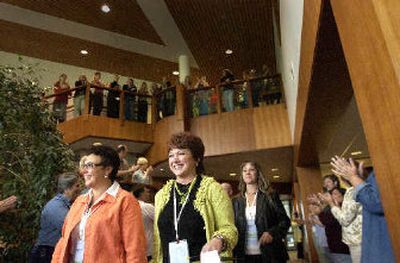Bert Caldwell: Emerging markets? They’re right here

Emerging markets, regions where new companies hold the promise of giant profits, are the rage among investors and money managers. India. Brazil. China. Those are the places to be. But what about the Inland Northwest?
Really, emerging understates what has happened in the region the last few years.
According to two new measures of investment performance created at Hart Capital Management Inc., the value of the Inland Northwest’s 15 largest public companies has quadrupled since March 31, 2003. In just the first quarter of 2006, the composite value jumped 24.7 percent, compared with 3.7 percent for the Standard & Poor’s 500.
Total value as of March 31; $12 billion. That, says Craig Hart, exceeds the total market capitalization of every public company in Argentina. You know, one of those emerging markets, although one that has had its problems.”Twelve billion is startling,” says Hart, Hart Capital’s president and chief investment officer. No one in Spokane’s investment community even came close when he asked them for their estimates on area company valuation.
Hart and the firm’s staff developed two yardsticks; one a composite that simply computes market capitalization, one an index calculated using the same formula S&P uses for its broader index of the 500 largest public companies in the United States.
He did not cherry pick the best-performing stocks, Hart says. He started with a geographic footprint encompassing Spokane, Coeur d’Alene and Sandpoint. The choices had to be operating companies, which excluded some mining company stocks that have rocketed in value the last year or so. And, because all must be publicly traded, economic stalwart Washington Trust Bank was also left out.
There are some surprising names. For example, Nighthawk Radiology Holdings Inc. Publicly traded for only 14 months, the Coeur d’Alene company is already worth $712 million. Sandpoint-based Intermountain Community Bancorp, holding company for Panhandle State Bank, registers an impressive $139.6 million.
But most surprising of all is the name at the top of the list: Coldwater Creek Inc. The retailer of women’s clothing and accessories is worth a glittering $2.6 billion. That’s more than twice the valuation of more familiar names like Avista Corp., Potlatch Corp. and Sterling Financial Corp.
Hart says the variety of companies, from mining to banking to hospitality to technology, allowed him to finally follow through on his longstanding desire to quantify the worth of the Inland Northwest’s leading companies.
“I don’t think we could have done this five years ago,” he says. “We just did not have the breadth.”
Although the stock in every company has appreciated markedly since the end of 2002, Hart says a few factors helped pump up the composite. The Nighthawk initial public offering is one. In terms of his composite, the company was worth zero three years ago. And the capitalization of Coeur d’Alene Mines increased substantially as the company restructured its finances, in the process converting debt into additional equity.
Unlike the composite, the index can adjust for those events, he says.
Hart says his company manages about $100 million in assets, mostly those of individual investors and small pension and profit-sharing programs. He characterizes Hart Capital holdings in the Inland Northwest companies as modest, but material.
“We do own some of these. Sometimes I wish we had more,” Hart says. “My clients are going to wish we had more.”
He says the composite and index are valuable to the Inland Northwest because they show investors there are attractive companies in the area. And seeing the wealth created should reassure entrepreneurs who may question whether the region will reward them financially if they build a successful business.
Three of the five most valuable companies — Coldwater Creek, Sterling and Itron Inc. — were not public companies 20 years ago.
“I’m just trying to bring forth the credibility and viability of investing locally,” Hart says. “In a way, this is an emerging market of its own.”
You certainly don’t have to cry for the Inland Northwest.